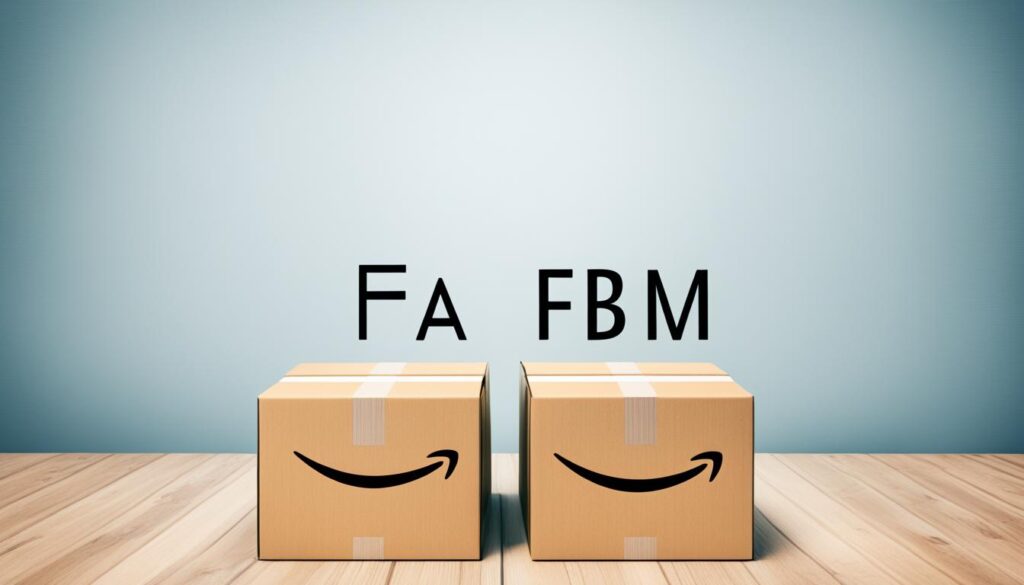Amazon E-Commerce : Selling on Amazon has become a lucrative opportunity in the world of e-commerce. With projected net sales of $162 billion in 2022, Amazon continues to dominate the online shopping landscape, offering unparalleled reach and potential for sellers.
Whether you’re a seasoned entrepreneur or just starting your online business journey, understanding the ins and outs of Amazon’s e-commerce platform is critical to achieving success. With this in mind, we’ve compiled a comprehensive guide to help you navigate the Amazon marketplace and maximize your sales potential.
In this article, we’ll explore proven strategies and tips to boost your Amazon e-commerce business, from market research and product sourcing to optimizing your product listings and advertising campaigns. We’ll also delve into fulfillment options, customer service excellence, and more. So, let’s dive in and uncover the tips that can unlock your success on Amazon’s platform.
Key Takeaways:
- Amazon’s e-commerce platform offers immense potential for online sellers.
- Thorough market research is crucial for identifying profitable niches and products.
- Optimizing your product listings and utilizing Amazon’s advertising campaigns can greatly enhance your visibility and sales.
- Choosing the right fulfillment method and providing exceptional customer service are essential for long-term success.
- Embrace the dynamic nature of Amazon’s marketplace and adapt your strategies to stay ahead of the competition.
Market Research and Niche Identification
Before diving into your Amazon e-commerce venture, it’s crucial to conduct comprehensive market research and identify a profitable niche. This essential step will help you understand the market landscape, target audience, and identify high-demand products with minimal competition. Fortunately, there are several tools at your disposal to simplify this process.
Two popular tools that can aid in market research are Jungle Scout and Helium 10. These powerful platforms offer invaluable insights into product demand, competition analysis, and historical sales data. By leveraging these tools, you can uncover profitable niches and make informed decisions for your Amazon business.
Another valuable resource is Amazon’s Best Sellers list. This list showcases the top-performing products across various categories. Analyzing the Amazon Best Sellers list allows you to identify trends, understand customer preferences, and discover potential niches to explore.
Remember, the key to success lies in finding a niche that combines high demand with low competition. This combination ensures that you have a market hungry for your products, while also reducing the risk of being overshadowed by intense competition.
Identifying Profitable Niches
When narrowing down a niche, consider the following factors:
- Target audience: Understand their needs, pain points, and purchasing behavior.
- Product demand: Look for products with a consistent, growing demand over time.
- Competition analysis: Evaluate the competition level in the chosen niche.
- Unique selling proposition (USP): Determine how your products can stand out and provide value in the market.
By carefully analyzing these factors, you can identify profitable niches that align with your business goals.
Using Market Research Tools
Here’s how you can leverage Jungle Scout, Helium 10, and Amazon’s Best Sellers list:
| Jungle Scout | Helium 10 |
|---|---|
| Provides insights into product demand, competition, and profitability | Offers comprehensive competitor analysis, keyword research, and listing optimization |
| Aids in estimating sales volume and revenue potential | Enables you to track keyword rankings, monitor competitors, and optimize product listings |
| Helps to discover profitable niches and product ideas | Assists in identifying profitable keywords for better visibility and sales |
By utilizing these tools, you’ll gain a competitive edge in your market research, allowing you to make educated decisions when selecting your niche and product offerings.
Conducting thorough market research and niche identification is a critical foundation for your Amazon e-commerce success. Take advantage of these powerful tools and data sources to understand the market and position your business for growth.
Setting Up Your Amazon Seller Account
When it comes to selling on Amazon, the first step is to set up your Amazon Seller account. This will give you access to the powerful tools and features of Amazon Seller Central, allowing you to manage your seller account effectively.
There are two types of seller accounts you can choose from: Individual and Professional. Let’s explore the differences between these two options and help you decide which one is best for your business.
Individual Account
If you are just starting out or plan to sell a small number of items, an Individual account may suit your needs. With an Individual account, you can list products on Amazon and pay a per-item fee when a sale is made. However, keep in mind that Individual accounts have some limitations:
- You cannot apply to sell in certain categories, such as clothing or jewelry.
- You cannot use advanced selling tools like Amazon’s Advertising Console or Enhanced Brand Content.
- There is no access to bulk listing or inventory management.
If you’re testing the waters or have a limited inventory, an Individual account can be a great way to get started with minimal upfront costs.
Professional Account
If you’re serious about growing your Amazon business and plan to sell more than just a few items, a Professional account is the better option. With a Professional account, you pay a monthly subscription fee of $39.99, but you gain access to a wide range of benefits:
- You can sell in all product categories available on Amazon.
- You have access to inventory management tools, making it easier to track and manage your stock.
- You can create your own product listings or modify existing ones.
- You are eligible for promotions and advertising options to boost your sales and visibility on Amazon.
Having a Professional account also allows you to create a brand presence, which is crucial for building trust and credibility with customers. You can include your company logo, customize your product detail pages, and enjoy other branding opportunities.
Setting up your Amazon Seller account is simple. Just follow these steps:
- Go to https://sellercentral.amazon.com/.
- Click on the “Register now” button and follow the prompts to create your account.
- During the setup process, you’ll need to provide some basic information about your business, such as your business name, contact information, and bank account details for receiving payments.
- Amazon will also require you to complete an identity verification process to ensure the security of the marketplace.
- Once your account is set up and verified, you can start listing your products and selling on Amazon!
Having an Amazon Seller account opens up a world of opportunities to reach millions of customers and grow your business. So, whether you choose an Individual or Professional account, get started today and start selling on Amazon!

Strategic Product Sourcing
When it comes to building a successful Amazon business, strategic product sourcing is crucial. Whether you choose to manufacture your own products or source them from suppliers, ensuring quality and competitiveness is key. To find reliable partners, consider the following options:
- Alibaba: Alibaba is an online marketplace that connects businesses with manufacturers and suppliers worldwide. It offers a vast range of products, making it an excellent platform for product sourcing.
- ThomasNet: ThomasNet is a leading platform that connects buyers with North American manufacturers and distributors. If you prefer to support local businesses and reduce shipping times, ThomasNet is a valuable resource.
- Local Manufacturers: Don’t overlook the potential of partnering with local manufacturers in your area. They often offer personalized service, quicker turnaround times, and the ability to build strong relationships.
Before finalizing any sourcing decisions, it’s essential to thoroughly research suppliers, assess product quality, compare prices, and negotiate favorable terms. Remember, the success of your Amazon business heavily relies on the quality and competitiveness of the products you offer.
Now let’s take a look at a table that compares the key features of these product sourcing options:
| Product Sourcing Option | Key Features |
|---|---|
| Alibaba |
|
| ThomasNet |
|
| Local Manufacturers |
|

Optimizing Your Product Listings
When it comes to selling on Amazon, optimizing your product listings is crucial for maximizing visibility and attracting customers. By crafting compelling titles, engaging descriptions, and incorporating high-quality images, you can significantly enhance your chances of success. Additionally, leveraging Amazon’s Enhanced Brand Content can add visual appeal to your listings and further entice potential buyers. Let’s explore the key elements of optimizing your product listings:
Crafting Compelling Product Titles
The product title is the first thing customers see, so it’s vital to make it informative and attention-grabbing. Include relevant keywords that accurately describe your product to improve its discoverability. However, avoid keyword stuffing and prioritize creating concise, clear, and compelling titles that resonate with your target audience.
Writing Engaging Product Descriptions
A well-written product description serves as your virtual sales pitch. Highlight the unique features and benefits of your product, helping customers understand why they should buy it. Be descriptive, use bullet points or paragraphs to break down essential information, and engage readers with persuasive language. Remember to include relevant keywords naturally throughout the description.
Utilizing High-Quality Product Images
High-quality images are essential to showcase your products effectively. Make sure to use professional, well-lit photographs from multiple angles. If applicable, provide lifestyle images or product demonstrations to give customers a better understanding of what they can expect. Including images that demonstrate the size, color variations, or product dimensions can also be helpful.
Leveraging Enhanced Brand Content
Enhanced Brand Content (EBC) is a feature that allows sellers to enrich their product detail pages with visually stunning content. With EBC, you can incorporate additional images, videos, and interactive elements to tell a compelling brand story and create an immersive shopping experience for customers. Take advantage of this feature to elevate your product listings and leave a lasting impression on potential buyers.

Optimizing your product listings is not a one-time task. Continuously monitor and analyze the performance of your listings and make adjustments as needed. By fine-tuning your titles, descriptions, and images based on customer feedback and market trends, you can maintain a competitive edge in the Amazon marketplace.
Pricing and Profitability Analysis
When it comes to selling your products on Amazon, setting the right prices is crucial for both attracting customers and ensuring profitability. To achieve this delicate balance, consider various factors that impact your pricing strategy.
First and foremost, you need to calculate your product costs accurately. This includes manufacturing or sourcing costs, packaging expenses, and any other related fees. Additionally, take into account the fees charged by Amazon, such as referral fees and fulfillment fees.
Shipping costs also play a significant role in determining your prices. Evaluate different shipping options and their associated expenses to find the most cost-effective solution for your business.
Moreover, keep in mind any potential discounts you might offer to incentivize customers and increase sales. These could include promotional codes, limited-time offers, or bundle deals.
To streamline this pricing and profitability analysis process, you can utilize useful tools like the Amazon FBA calculator. This tool helps you estimate your potential profitability by taking into account various costs and fees, allowing you to make informed decisions about your pricing strategy.

Remember, while competitive pricing is important to attract customers, it’s equally crucial to ensure profitability for your business. Strike the right balance for optimal success on the Amazon marketplace.
Fulfillment Method: FBA or FBM?
When it comes to choosing the fulfillment method for your Amazon business, you have two options: Fulfillment by Amazon (FBA) or Fulfillment by Merchant (FBM). Understanding the pros and cons of each option is crucial in making an informed decision that aligns with your business strategy.
The Pros and Cons of Fulfillment by Amazon (FBA)
Fulfillment by Amazon (FBA) is a popular fulfillment method that allows sellers to store their products in Amazon’s fulfillment centers. Here are some advantages and disadvantages of using FBA:
| Pros of FBA | Cons of FBA |
|---|---|
| 1. Amazon handles storage, packaging, and shipping. | 1. Fees associated with storage, shipping, and inventory management can be higher compared to FBM. |
| 2. Prime eligibility, offering faster shipping and access to Prime customers. | 2. Limited control over shipping process and logistics. |
| 3. Multichannel fulfillment, allowing you to fulfill orders from other sales channels. | 3. Risk of commingling inventory with other sellers, potentially leading to product quality issues. |
The Pros and Cons of Fulfillment by Merchant (FBM)
Fulfillment by Merchant (FBM) is an alternative fulfillment method where sellers handle storage, packaging, and shipping themselves. Here are the advantages and disadvantages of using FBM:
| Pros of FBM | Cons of FBM |
|---|---|
| 1. Greater control over shipping and logistics. | 1. You are responsible for storage, packaging, and shipping, which can be time-consuming. |
| 2. Lower overall fees compared to FBA. | 2. Not eligible for Prime shipping, potentially impacting customer reach. |
| 3. Flexibility to customize packaging and branding. | 3. Limited ability to fulfill orders from other sales channels. |
Ultimately, the fulfillment method you choose will depend on your specific business needs and goals. Consider factors such as product type, order volume, cost structure, and customer expectations when deciding between FBA and FBM.

Using FBA can give you access to Amazon’s vast customer base and Prime benefits, but it comes with higher fees and less control over the fulfillment process. On the other hand, FBM provides more control and potentially lower costs, but lacks Prime eligibility. Assess your priorities and weigh the pros and cons to determine which fulfillment method best suits your business.
Amazon Advertising Campaigns
When it comes to promoting your products on Amazon, launching Amazon PPC campaigns is essential. Pay-Per-Click (PPC) advertising allows you to increase your product visibility and reach potential customers effectively. By targeting relevant keywords, you can connect with shoppers actively searching for products similar to yours.
Starting with a modest budget is advisable, especially if you’re new to Amazon PPC campaigns. This will help you test different strategies and evaluate their performance without investing too heavily upfront. As you gain insights from campaign performance, you can adjust your advertising strategy to optimize results and increase your return on investment.
To enhance the effectiveness of your Amazon PPC campaigns, it is crucial to focus on keyword targeting. By selecting the right keywords, you can ensure your ads are displayed to the most relevant audience. Conduct thorough keyword research using tools like Amazon’s own Keyword Planner, as well as third-party tools like SEMrush or Ahrefs.
Remember to regularly monitor the performance of your Amazon PPC campaigns. Analyze key metrics such as click-through rate (CTR), conversion rate, and cost per click (CPC) to understand how your campaigns are performing. This data will help you make data-driven decisions and optimize your advertising strategy over time.
Pro Tip: Consider utilizing Amazon’s Sponsored Products, Sponsored Brands, and Product Display Ads to diversify your advertising strategy and reach different segments of your target audience.
To illustrate the impact of Amazon PPC campaigns, consider the following example:
| Before Amazon PPC Campaign | After Amazon PPC Campaign |
|---|---|
| Organic product visibility | Increased product visibility due to sponsored ads |
| Limited reach and exposure | Expanded reach and exposure to a wider audience |
| Lower click-through rate (CTR) | Improved click-through rate (CTR) and increased traffic |
| Inconsistent sales performance | Steady increase in sales and revenue |

Embracing Amazon PPC campaigns as part of your advertising strategy is crucial for driving product visibility, increasing sales, and achieving overall success on the Amazon platform. By adopting the right approach and continuously optimizing your campaigns, you can effectively reach your target audience and maximize your return on investment.
Customer Service Excellence
Prioritize exceptional customer service to build customer loyalty. Respond promptly to inquiries, address issues professionally, and provide positive experiences. Positive reviews and repeat business are essential for success on Amazon.
Why Customer Service Matters
Customer service is a critical component of any successful business, and selling on Amazon is no exception. Exceptional customer service can help differentiate your brand from competitors, build trust with customers, and ultimately drive positive reviews and repeat business. According to a study by PwC, 73% of consumers say that customer experience plays a role in their purchasing decisions. By providing exceptional service, you can not only meet but exceed customer expectations, creating a positive shopping experience that encourages customers to return and share their positive experiences with others.
Also read : Common Mistakes to Avoid for Online Money Making
Tips for Providing Exceptional Customer Service on Amazon
- 1. Promptly Respond to Inquiries: Be proactive in addressing customer inquiries and concerns. Respond to messages and emails promptly to show customers that you value their time and are committed to resolving any issues they may have.
- 2. Address Issues Professionally: When customers have concerns or encounter problems with your products or services, approach the situation professionally and empathetically. Offer solutions and take responsibility for rectifying the situation to ensure customer satisfaction.
- 3. Provide Positive Experiences: Go above and beyond to provide memorable experiences for your customers. Consider adding a personal touch, such as handwritten thank-you notes or unexpected bonuses with their purchases. These small gestures can leave a lasting impression and foster customer loyalty.
The Impact of Positive Reviews
Positive reviews are not only a testament to your exceptional service but also serve as social proof, influencing purchasing decisions for potential customers. According to BrightLocal, 82% of consumers read online reviews before making a purchase, and positive reviews can lead to a 31% increase in revenue. By consistently delivering exceptional customer service, you increase the likelihood of receiving positive reviews, which can significantly impact your sales and reputation on the Amazon marketplace.
| Benefits of Positive Reviews | Influence on Potential Customers |
|---|---|
| Build trust and credibility | 88% of consumers trust online reviews as much as personal recommendations |
| Attract more customers | 94% of consumers say that a positive review convinces them to use a business |
| Improve search rankings | Positive reviews can boost your visibility in Amazon search results |
| Drive sales | Customers are more likely to purchase products with positive reviews |
By consistently providing exceptional customer service and delivering positive experiences, you can cultivate a strong reputation on Amazon, attract more customers, and drive sales. Remember, customer service is not just a one-time investment but an ongoing commitment to building relationships with your customers and ensuring their satisfaction.
Conclusion
Launching an Amazon business opens up a world of possibilities for success in the e-commerce landscape. By following the tips provided in this article, you can position yourself for growth and prosperity in the online marketplace.
With a projected net sales of $162 billion in 2022, Amazon remains a dominant force in the e-commerce industry. By understanding market research and identifying profitable niches, setting up a well-optimized Amazon seller account, strategically sourcing products, and optimizing your product listings, you can enhance your chances of success.
Moreover, pricing your products appropriately, selecting the right fulfillment method, driving visibility through Amazon advertising campaigns, and delivering exceptional customer service are essential components of a thriving Amazon e-commerce business. Remember, adaptability to changes and embracing the dynamic nature of the online marketplace are key.
As you embark on your Amazon e-commerce journey, put these strategies into action, and stay committed to continuous improvement. With dedication and perseverance, your Amazon business can thrive and achieve remarkable success in the competitive online marketplace. Good luck!
FAQ
Q: What is the significance of Amazon e-commerce in the retail industry?
A: Amazon e-commerce has transformed the retail industry by revolutionizing the way people shop, setting new standards for customer service, and offering a wide range of products through a convenient online platform.
Q: How can Amazon e-commerce help businesses increase their revenue?
A: Amazon e-commerce provides businesses with a global platform to reach a wider customer base, tap into the massive consumer base of Amazon Prime members, and leverage Amazon’s fulfillment services for efficient order processing and delivery.
Q: What role does Amazon Fulfillment play in the success of e-commerce businesses?
A: Amazon Fulfillment services enable businesses to store their products in Amazon’s fulfillment centers, manage their inventory, and benefit from Amazon’s efficient order processing and delivery network, thereby enhancing the customer experience and streamlining operations.
Q: How does Amazon’s use of generative AI impact its e-commerce operations?
A: Amazon utilizes generative AI to enhance various aspects of its e-commerce operations, such as personalizing product recommendations, optimizing supply chain management, and improving customer service through chatbots and voice assistants like Alexa.
Q: What are the key business decisions that businesses can make by leveraging Amazon’s e-commerce platform?
A: Businesses can make strategic decisions regarding product offerings, pricing strategies, fulfillment options, and marketing campaigns by leveraging Amazon’s e-commerce platform. They can also utilize data analytics and customer insights to make informed decisions.
Q: How does Amazon’s e-commerce model differ from traditional brick-and-mortar retail?
A: Amazon’s e-commerce model offers a seamless online shopping experience, scalable infrastructure for businesses, and access to a global customer base, whereas traditional brick-and-mortar retail involves physical stores, in-person customer interactions, and localized operations.
Q: What are the implications of Amazon’s e-commerce announcements for the year 2023?
A: Amazon’s announcements for 2023 may include new features, expansions, technological advancements, and strategic partnerships geared towards enhancing the e-commerce experience for both customers and businesses.
Q: How does Amazon’s use of artificial intelligence (AI) contribute to its e-commerce success?
A: Amazon harnesses AI to improve inventory management, optimize product recommendations, enhance customer engagement through virtual assistants like Alexa, and streamline various aspects of its e-commerce ecosystem to deliver a personalized and efficient shopping experience.
Q: What impact does Amazon Prime have on the e-commerce landscape?
A: Amazon Prime membership offers benefits such as free and fast shipping, access to exclusive deals, streaming services, and more, thereby influencing consumer behavior, fostering customer loyalty, and shaping the e-commerce landscape.
Q: How does Amazon’s e-commerce infrastructure, including AWS, support businesses?
A: Amazon’s e-commerce infrastructure, including Amazon Web Services (AWS), provides businesses with cloud computing, database storage, and various tools for website hosting, data analytics, and application development, empowering them to scale their operations and innovate in the digital space.




